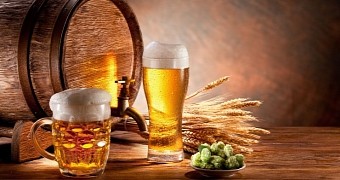Let's face it, fruit flies are by no means everybody's favorite insects. Most of us think of them as pests, and some people find them downright disgusting. The thing is that, as unpopular as they might be, fruit flies are actually quite useful. At least when it comes to keeping the beer industry alive.
In a paper published in the journal Cell Reports this past October 9, researchers say that, as surprising as this may sound, it's fruits flies that give beer its distinctive scent and aroma. Otherwise put, they say that, without them, beer would be far less appealing.
What do fruit flies have to do with beer?
A lot, apparently. Thus, scientists say that, having studied the genetic makeup of common brewer's yeast, they found that this microorganism evolved to produce an odor that attracts fruit flies, on which the fungus depends to spread.
As detailed in the journal Cell Press, the common brewer's yeast, whose official and science-approved name is Saccharomyces cerevisiae (good luck reading it), is a central figure in baking and in the fermentation of beer.
Interestingly enough, researchers say that the same odor that this type of yeast produces in order to attract fruit flies and have them disperse its cells is the same one that gives beer its scent and aroma. This means that, but for fruit flies, beer would probably not entice our noses all that much.
“Two seemingly unrelated species, yeasts and flies, have developed an intricate symbiosis based on smell,” Belgian researcher Kevin Verstrepen said in a statement, as cited by Phys Org. “The flies can feed on the yeasts, and the yeasts benefit from the movement of the flies,” he added.
An accidental discovery
The best part about this piece of news is that scientists found that fruit flies indirectly influence beer scent and aroma quite by chance. Thus, this find was merely the result of a mishap at a research facility in Belgium.
Writing in the journal Cell Press, Kevin Verstrepen explains that, about a decade and a half ago, when he was just a student, he got to work studying yeast cells used to make beer and wine. As part of his research, he created several mutant yeast strains.
One weekend, some fruit flies from a lab close to the one he was working in found their way to his flasks. Much to his surprise, the scientist found that the insects all gathered around the yeast packing a gene dubbed ATF1 for acetyl transferase, and ignored the mutants.
“When returning to the lab after a weekend, I found that a flask with a smelly yeast culture was infested by fruit flies that had escaped from a neighboring genetics lab, whereas another flask that contained a mutant yeast strain in which the aroma gene was deleted did not contain any flies,” Kevin Verstrepen detailed in an interview.
It was years later that Kevin Verstrepen got around to studying this romance between yeast and fruit flies in further detail, and found that the fungus' genetic makeup is designed in such a way to help it attract said insects. The scientist completed this research project together with fly neurobiologists Emre Yaksi and Bassem Hassan.

 14 DAY TRIAL //
14 DAY TRIAL //